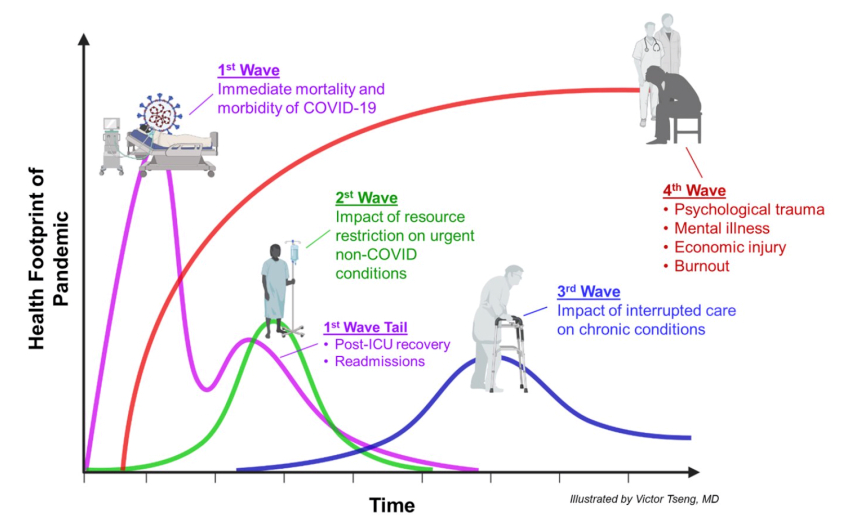China: hospitals overwhelmed by the giant wave of Covid cases

The tremendous wave of Covid-19 infections that China has suffered since it abruptly ended strict lockdowns and mass testing on December 7 is causing millions of cases daily, although only a few deaths have been officially admitted since that date. Two journalists from the Associated Press agency toured an area in the interior of the country to verify the situation in situ.
Yao Ruyan walked frantically outside a hospital "fever clinic" in China's industrial Hebei province, 70 kilometers southwest of Beijing. Her mother-in-law had Covid-19 and needed urgent medical attention, but all the nearby hospitals were full. “They say there are no beds here”, she barked into her phone.
Emergency rooms in small cities and towns southwest of Beijing are overwhelmed. Intensive care units reject ambulances, relatives of the sick are looking for beds, and patients are slumped on benches in hospital corridors and lying on the floor for lack of beds.
Yao's elderly mother-in-law had fallen ill a week ago. They first went to a local hospital, where lung scans showed signs of pneumonia. But the hospital could not handle serious cases of Covid-19, Yao was told. They asked her to go to larger hospitals in adjacent counties.
As Yao and her husband drove from hospital to hospital, they found that all the wards were full. The Zhuozhou hospital, an hour's drive from Yao's hometown, was the latest disappointment.
Yao charged toward the check-in counter, passing wheelchairs frantically wheeling elderly patients. Once again, they told him that the hospital was full and he would have to wait. “I'm furious,” Yao said, crying. “I don't have much hope. We've been gone a long time and I'm terrified because she's having trouble breathing."
Over two days, Associated Press journalists visited five hospitals and two crematoriums in towns and small cities in Baoding and Langfang prefectures in central Hebei province. The area was the epicenter of one of China's first outbreaks after the state reversed strict controls effective Dec. 7, following massive protests in November. For weeks the region was silent as people fell ill and stayed home.
Many have already recovered. Today, markets are crowded, diners fill restaurants and cars honk in traffic, even as the virus is spreading in other parts of China. In recent days, state media headlines have said the area is returning to normal.
But life in the emergency rooms and crematoriums of central Hebei is anything but normal. Even as young people are back to work and lines at fever clinics are thinning, many of Hebei's elderly are in critical condition. As ICUs and funeral homes invade, it could be a harbinger for the rest of China.
The Chinese government has reported just seven Covid deaths since restrictions were dramatically eased on December 7, bringing the total and official death toll in the country to 5,241. deaths from pneumonia or respiratory failure in its official number of deaths from Covid, a restrictive definition that excludes many deaths that would be attributed to Covid-19 in other countries.
On Thursday it was learned through the Bloomberg news agency and the Financial Times newspaper that an internal minute of the national body in charge of the pandemic, the NHC, admitted that up to 248 million people had been infected since December 7, and that this week there was a daily peak, on Tuesday, of 37 million Covid cases. China did not officially confirm or deny this report. But the absurd number of 7 official deaths is denied by the panorama that is observed in crematoriums, funeral homes and hospitals. Even only in Beijing, a city that is more within the reach of foreign media journalists.
Experts have forecast between 1 million and 2 million deaths in China through the end of next year, with a senior World Health Organization (WHO) official warning that Beijing's way of counting would "underestimate the true death toll." .
At Baoding No. 2 Hospital in Zhuozhou on Wednesday, patients thronged the corridor of the emergency room. The sick breathed with the help of respirators. A woman mourned after doctors told her a loved one had died. The ICU was so full that ambulances were turned away. A medical worker yelled at relatives bringing a patient from an arriving ambulance.
"There is no oxygen or electricity in this corridor!" exclaimed the worker. "If you can't even give him oxygen, how can you save him?"
Another negative aspect of China is that it has only been able to give three doses of vaccine to 42% of the population over 80 years of age, the most vulnerable age segment and one of the most numerous in a country that has aged markedly. And it must be taken into account that China is the most populous country on the planet, with 1.410 million inhabitants.
Chinese vaccines, the only ones administered in the country, also turned out to be provenly ineffective, with outdated technology. Countries that bought them in 2021 are replacing them with US or European vaccines.
On Thursday it was learned through the Bloomberg news agency and the Financial Times newspaper that an internal minute of the national body in charge of the pandemic, the NHC, admitted that up to 248 million people had been infected since December 7, and that this week there was a daily peak, on Tuesday, of 37 million Covid cases.
Post a Comment for "China: hospitals overwhelmed by the giant wave of Covid cases"